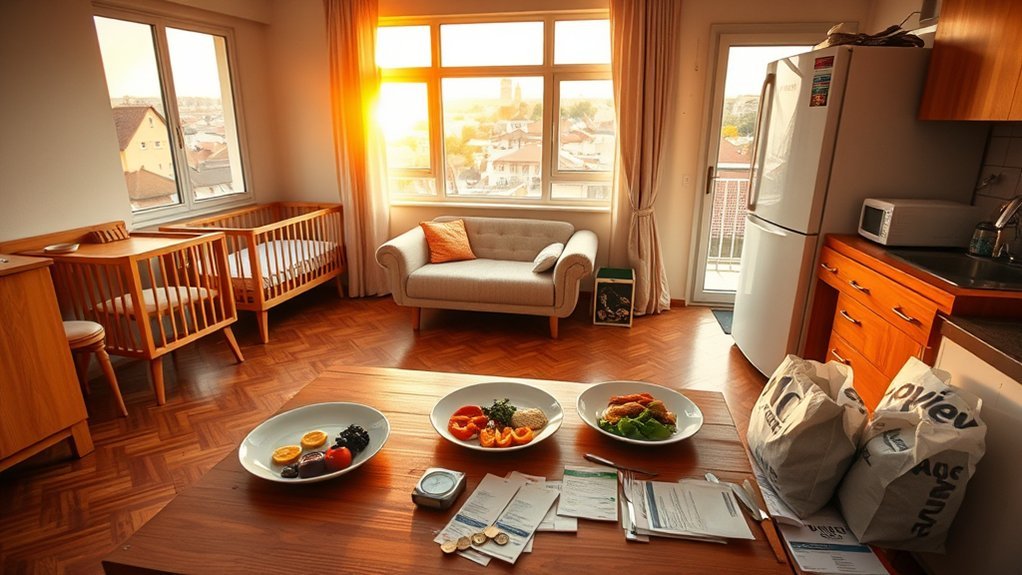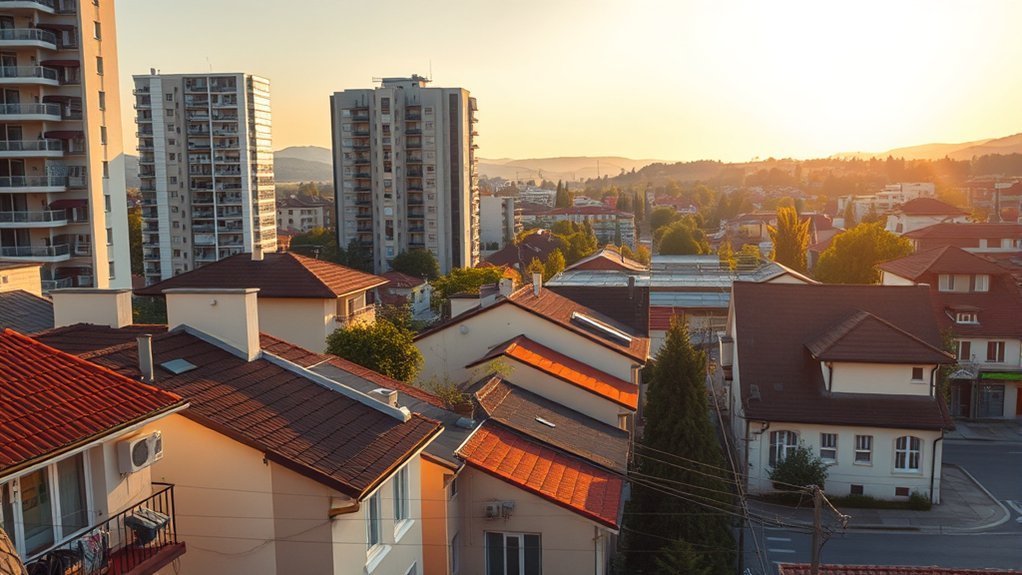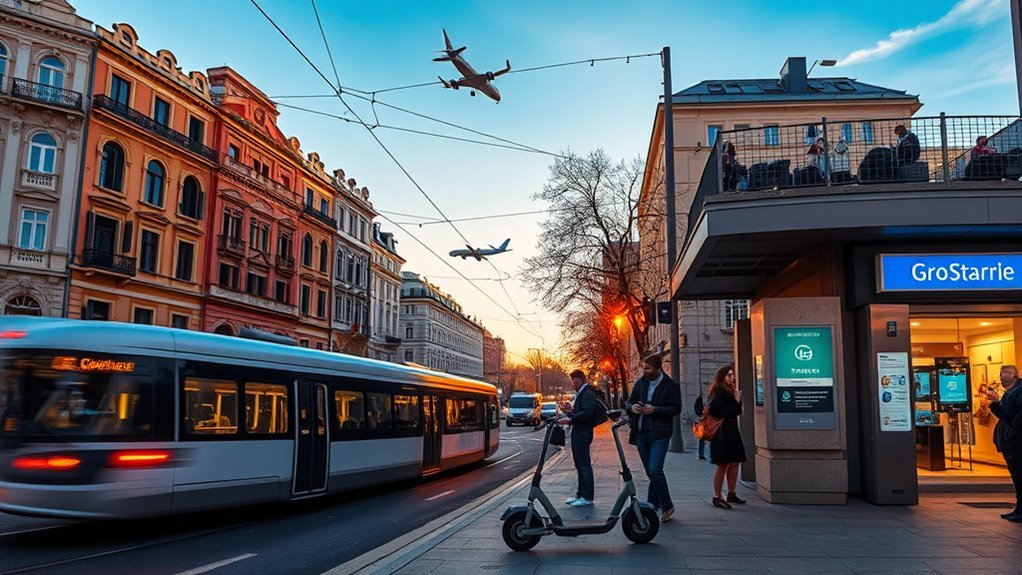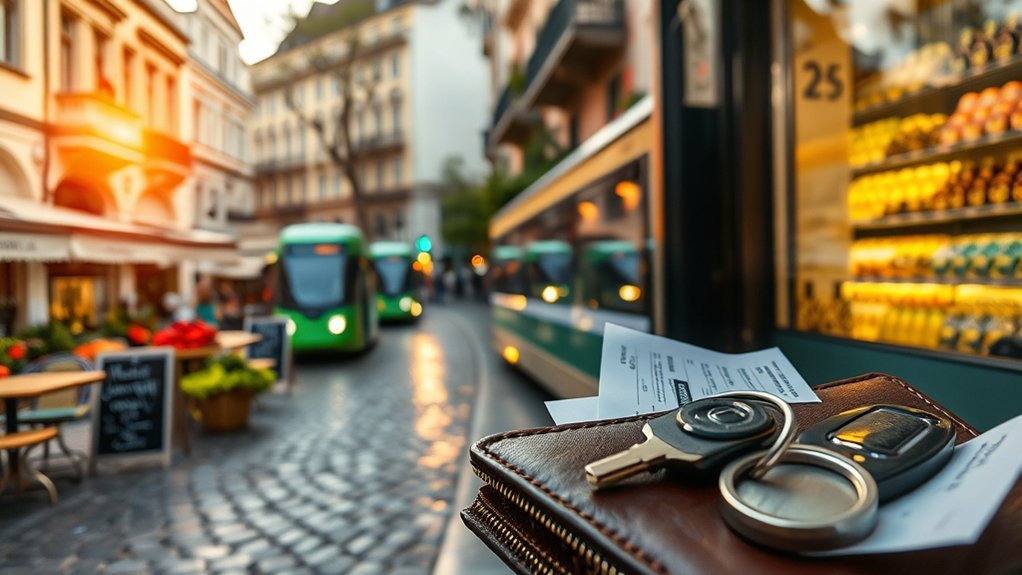You can live comfortably in Romania for about €700–€1,200 a month as a single person, €1,200–€2,000 as a couple, and roughly €2,500–€3,000 for a small family, though city and housing choices matter. Expect one-bedroom rent €250–€750, utilities €80–€150, groceries €150–€250, and public transport €16–€32 monthly (depending on city and whether you need metro integration). Healthcare and insurance add €30–€100 if you go private. Keep reading to see detailed budgets, savings tips, and city comparisons.
Monthly Budget Breakdown for Singles, Couples, and Families

While exact figures depend on city and lifestyle, you can expect a single person in Romania to spend roughly €700–€1,200 per month for rent, groceries, utilities and dining out; couples typically see costs rise to €1,200–€2,000; and a family of three should budget about €2,500–€3,000 monthly to cover housing, food and basic services.
For planning, use these averages to estimate your average cost of living: a one-bedroom apartment in Bucharest or Cluj-Napoca typically rents for €500–€700, smaller towns drop to €250–€350.
Your monthly grocery costs as a single person will usually sit between €150–€250 if you shop markets and local stores. Couples will see shared expenses reduce per-person spending but increase total living costs.
Families of three face higher healthcare, schooling and food bills, so allocate more to essentials. Track actual receipts to adjust this practical, data-driven baseline to your needs.
Housing Costs: Rent, Utilities, and Where to Live

Having a realistic monthly budget means your next big focus should be housing, since rent and utilities will take the largest share of living costs. You’ll find housing costs vary: a one-bedroom apartment in Bucharest runs €500–€750, in Cluj-Napoca €450–€700, and outside centers €250–€400. Utilities for small apartments average €80–€150/month; expect higher bills in winter. Internet is €8–€12 monthly and rarely a budget strain. Choose city center for convenience or periphery for cheaper accommodation; factor commuting costs.
| Location | Typical rent (1BR) | Notes |
|---|---|---|
| Bucharest | €500–€750 | Largest job market, higher demand |
| Cluj-Napoca | €450–€700 | Tech hub, popular with students |
| Outside centers | €250–€400 | Cheaper, longer commute |
| Utilities & Internet | €80–€150 + €8–€12 | Seasonal heating increases costs |
Plan by combining rent, utilities, and local transport when calculating living in Romania.
Food, Groceries, and Dining Out Prices

If you shop smart and cook at home most nights, your monthly food bill in Romania will usually fall between €150 and €250, with individual items noticeably cheaper than in Western Europe.
You’ll find groceries affordable: 1 liter of milk (dairy products) is about 4.5 RON (~€1), chicken breast ~20 RON/kg (~€4.4), bread €1.5–2, and a dozen eggs €2–3.
Dining out prices remain reasonable; an inexpensive restaurant meal is ~25 RON (~€5.5), while mid-range meals for two run ~90 RON (~€20).
- Milk (1 L): 4.5 RON (~€1)
- Chicken (1 kg): 20 RON (~€4.4)
- Inexpensive restaurant meal: 25 RON (~€5.5) / €6–€10 typical
- Bread & eggs: €1.5–2 (bread), €2–3 (eggs)
Plan meals to keep monthly food costs near the lower end.
If you dine out frequently, expect costs to rise but still stay below Western European averages.
Transportation, Communication, and Travel Expenses

After you’ve sorted food and dining, the next monthly costs to check are transport, communication, and travel — all of which stay quite affordable in Romania.
You’ll find transportation options that fit tight budgets: public transport monthly passes typically cost €16–€32 (city and integration dependent: e.g., single-system passes around €16–€20 in Bucharest, integrated STB+Metro about €32; Cluj monthly around €26), so commuting is cheap if you use buses, trams, or metros. If you prefer taxis, expect taxi fares around 2.0–2.6 RON per km (about €0.40–€0.55), with some operators closer to 3 RON/km, useful for short trips or nights out.
Internet services are very reasonable, usually €8–€12 per month, so staying connected won’t strain your budget. Fuel costs average €1.50–€1.70 per liter, which keeps driving costs lower than in many Western European countries.
For occasional international travel, bus tickets to neighboring countries range roughly €75–€110, while train fares run about €65–€110 depending on destination.
Healthcare, Education, and Insurance Costs

Romania’s public healthcare is financed via a mandatory health contribution (CASS) of 10% on income. If you’re uninsured, you can opt in by paying approximately 2,430 RON per year (~€490) for 12 months of coverage.
If you want faster access or broader coverage, private expat insurance typically runs €30–€100 per month and often includes private clinics and international care.
Compare what’s covered, copays, and network hospitals so you pick the most cost-effective option for your needs.
Public Healthcare Access
Although public healthcare in Romania is primarily funded through government and individual contributions, residents get broadly free access to services. Individuals are covered through the 10% CASS on income; those currently uninsured can opt in by paying about 2,430 RON/year for 12 months of coverage. Emergency healthcare is available regardless of prior insurance, so you’ll get immediate care when needed.
Consider these points:
- Coverage: core services are covered under public healthcare with minimal direct costs for residents.
- Cost: 10% CASS on income; uninsured opt-in is ~2,430 RON/year (~€490) for 12 months’ coverage.
- Quality: varies by region; urban areas outperform rural ones.
- Gaps: many expats choose private health insurance for broader coverage.
Private Insurance Options
Public healthcare will cover core services, but many expats opt for private policies to get faster care and wider coverage; private health insurance typically runs €30–€100 per month and can make a big difference in access and wait times. You’ll still owe CASS if applicable (or the uninsured opt-in described above), but private healthcare services reduce delays and expand provider choice. International school tuition as part of education options in Romania ranges roughly €10,000–€24,000+ yearly, so factor schooling plus insurance into budgets. You can add travel-risk or specialist plans for extensive support. Compare deductibles, networks, and exclusions to match coverage to your family’s needs.
| Type | Typical cost |
|---|---|
| Public contribution (CASS) | 10% of income; uninsured opt-in ~2,430 RON/year (~€490) |
| Private health insurance | €30–€100 |
| Intl school tuition | €10,000–€24,000+ |
| Travel/specialist plans | Variable |
| Out-of-pocket risk | Depends on policy |
Tips to Save Money and Estimate Your Required Salary

To cut housing costs, consider suburbs or smaller cities where one-bedroom rent can be €250–€350 versus €350–€600 in Bucharest.
Shop smart for groceries—basics like a liter of milk cost about 4.5 RON (~€1) and restaurant meals roughly 25 RON (~€5.5)—and use weekly lists and local markets to lower your food bill.
Optimize transport with a €16–€32 monthly pass (depending on city and integration) and target a family monthly income of €2,500–€3,000 to comfortably cover housing, food, utilities, and other expenses.
Cut Housing Costs
If you want to cut housing costs in Romania, start by comparing rents across locations and housing types: a one-bedroom in Bucharest runs about €500–€750, whereas smaller towns often list €250–€350, and shared rooms for international students can drop to €150–€300.
Use rental websites like Imobiliare.ro and OLX.ro to benchmark the cost of renting and spot deals. Budget utilities (€80–€150/month for a small apartment) into your total monthly estimate.
Consider new buildings to avoid repair costs.
- Choose smaller towns or outskirts — rent’s affordable compared to Bucharest.
- Opt for shared accommodation to lower per-person rent.
- Include utilities in your required salary calculation.
- Compare listings on multiple rental websites before committing.
Smart Grocery Shopping
Once you’ve narrowed down affordable housing, smart grocery shopping will shave more off your monthly bills: buy staples at local markets where milk runs about 4.5 RON (≈€1) per liter and chicken breast about 20 RON (≈€4.4/kg), and you’ll cut food costs considerably versus supermarket prices.
You should plan a monthly groceries budget of roughly €150–€250 per person; families of three can expect €350–€500. Track prices, buy seasonal produce, and prefer bulk staples to lower your Cost per meal.
Eating occasionally at inexpensive restaurants (~25 RON/€5.5) can be economical and saves prep time.
When estimating salary needs, include rent and utilities so your total monthly expenses fit within the €700–€1,200 range for comfortable living.
Optimize Transportation Spending
While public transit keeps daily commuting cheap—monthly passes run about €16–€32 depending on city and integration—you should budget roughly RON 90 (~€18) per month for overall transport and mix options to cut costs: use passes for routine trips, grab taxis (≈2.0–2.6 RON/km) only when necessary, and take regional trains or buses for longer journeys since tickets usually beat fuel and parking expenses.
Balance that with other living in Romania costs when estimating your salary.
- Use public transportation and monthly passes for daily commutes to minimize transportation expenses.
- Reserve taxis for late-night or multi-stop trips; track per-km rates.
- Prefer regional trains/buses for intercity travel; tickets often undercut driving.
- If you drive or use electric vehicles, factor seasonal utility costs (heating, charging) into budgets.
Frequently Asked Questions
Is Romania a Good Place for Americans to Live?
Yes — you’ll find Romania affordable, safe, and modern, with cities like Bucharest and Cluj offering good healthcare, lower housing costs, vibrant culture, and varied climate; you’ll still need vigilance against petty theft in crowded areas.
What’s the Average Price of a House in Romania?
Average house prices vary widely: you’ll find rural homes under €30,000, small-town houses €40,000–€80,000, while urban and Bucharest properties often range €100,000–€250,000, with premium listings considerably higher.
Can a US Citizen Live in Romania?
Yes — you can live in Romania; you’ll need a long-stay visa or residence permit, show proof of funds, accommodation, and health coverage. Expect monthly costs roughly €700–€1,200; private insurance €30–€100.
How Much Is Rent per Month in Romania?
Rent usually runs €250–€750 per month for a one-bedroom: expect €500–€750 in Bucharest, €450–€700 in Cluj, €300–€550 in Timișoara, and €250–€400 in smaller cities; outskirts are cheaper.
Conclusion
Living in Romania can be surprisingly affordable, but plan carefully: rent, utilities, food, transport, healthcare, and schooling typically take most of your budget. You’ll save more outside big cities like Bucharest, where costs spike; smaller towns and suburbs offer real value. Use the monthly breakdowns to estimate expenses for singles, couples, or families, and aim for a salary that covers essentials plus 10–20% for savings and unexpected costs.


